Art to Embrace the People Living in Disaster Affected Areas and Capture Their Memories
Teiko Hinuma (Program Director, Rikuzentakata AIR Program/Associate Professor at Joshibi University of Art and Design)
Norikazu Sato (Executive Director, NPO Japan Contemporary Dance Network)
Sioned Huws (Participating artist, Rikuzentakata AIR Program)
Cornelia Konrads (Participating artist, Rikuzentakata AIR Program)
Tawatchai Pattanaporn (Participating artist, Rikuzentakata AIR Program)
Throughout the Tohoku region, where efforts for reconstruction from the damage of the Great East Japan Earthquake are ongoing, numerous cultural and artistic organizations are taking action in their communities and searching for ways to assist the reconstruction through art. The emotional struggles borne by the victims, though not immediately visible, are something that cannot be overlooked as plans for economic and regional recovery are carried out. Art has the ability to reach out toward the inner worlds of these people, and greater importance will likely be placed on that ability as time passes.
Art brings out the pride and will to live in the people of the community. A new world can be created through the arts of the Tohoku region, known as a reservoir of traditional arts. With this awareness in mind, we have invited Norikazu Sato, who is executive director of the Japan Contemporary Dance Network and who started the Human Celebration-Sanriku International Arts Festival in summer 2014, Teiko Hinuma who is program director of the Rikuzentakata Artist in Residence Program and Associate Professor at the Joshibi University of Art and Design, and three artists who have been participating in the program to present their various projects and discuss their visions for their future activities. The first steps to rise up from the suffering of the earthquake and build a better future through culture and art, no matter how small, have already been taken. Let's take a look at these activities from the point of view of each of the project leaders.
(From the talk event "Tohoku no Mirai wo Tsukuro Ato no Sokojikara [The Hidden Power of Art Creating the Future of Tohoku]" given on December 11, 2014 at the Japan Foundation JFIC Hall "Sakura")
One day the dancers of the world may look toward the rich tapestry of traditional culture that is Tohoku
Teiko Hinuma: Today is December 11th. It is the "mensiversary" of the Great East Japan Earthquake, which occurred exactly three years and nine months ago. Every month, when the 11th rolls around, people everywhere are likely turning their thoughts to Tohoku. For those of us active in the Tohoku region, we continue our efforts with a sense of the speed with which three years can pass by, while we feel a growing sense of emotional distance with the areas outside of Tohoku.
The physical reconstruction itself is still very much a work in progress. It can be said that art, our form of contribution, serves as the foundation for the dignity of living. We believe that there is a need to create a new joy of living, lifestyle, and culture in the affected areas. To begin with, we are going to introduce Norikazu Sato, who is active in Sanriku.
Norikazu Sato: The Japan Contemporary Dance Network has an office in Kyoto and is active throughout Japan and the world. Following the Great East Japan Earthquake, I visited the affected areas with dance artists to provide programs to loosen the body. Loosening the body can relax the mind. So, we visited evacuation facilities and temporary housing where we gave advice, as specialists of the body, on how to relax, rather than simply dancing. As we continued this, we began wondering what else we could do for the affected areas beyond simply going there to do some activities. Just as we were thinking this, we happened to be introduced to people practicing local folk arts. While we were aware that the Tohoku region represented a treasure trove of folk arts, we had as yet not encountered any directly. However, as we spoke with many people, we came to realize that what had seemed remote to us was in fact all around us. There is an abundant array of folk arts throughout Tohoku, and everyone from children to the elderly are involved in one way or another. We understood that these arts served as a major force in forming communities.
Now I am going to show you videos of two studies carried out last year when we invited an artist from the U.K. for the program We're Gonna Go Learn in Tohoku!! We learned the traditional folk dance called "Kanatsuryu Shishi Odori (Deer Dance)" in Urahama District, Sanrikucho, Ofunato City, and the "Shichifukujin" (The Seven Gods of Luck) at a preschool at Massakicho, Ofunato City.
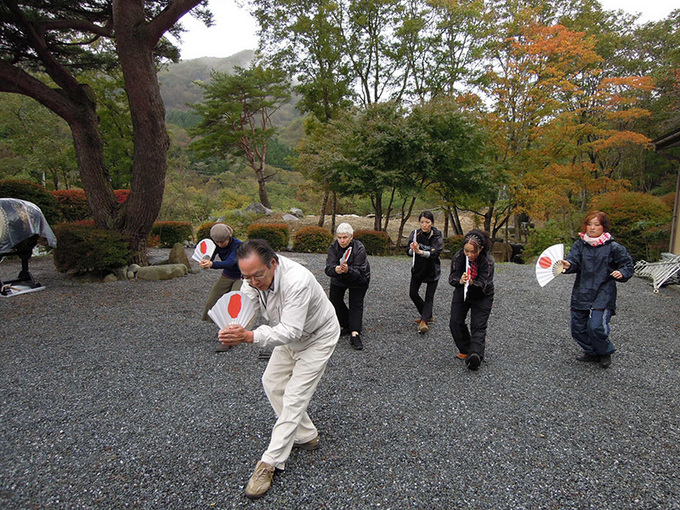
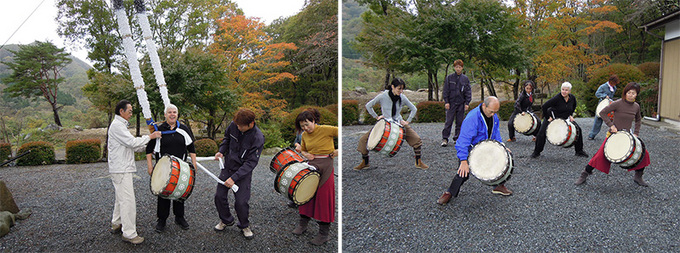
Members of the Japan Contemporary Dance Network and the U.K. artist Cecilia Macfarlane learning the "Kanatsuryu Shishi Odori" in Urahama District, Sanrikucho, Ofunato City.
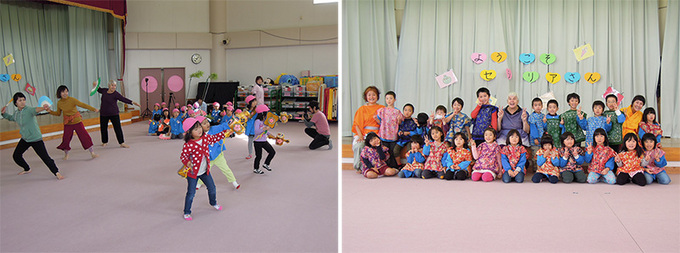
Learning "Shichifukujin" at a preschool in Massakicho, Ofunato City (Left)
Cecilia being welcomed by the children at the preschool (Right)
(Photos: Japan Contemporary Dance Network)
By living in the community, interacting with the local people, and learning their folk arts, we came to feel that the arts passed down through generations throughout Japan were not simply something to present or perform, but were in fact a tool to connect generations and to pass down something very important but intangible within each community. Thus we, as visitors to Tohoku from the outside, came to believe that rather than simply going there to do something we, as dance professionals could better serve by going to carry on the tradition of folk art that the Japanese art scene had lost.
In Bali, Indonesia, people from throughout the world gather to learn the traditional dance form of gamelan. There are even Balinese gamelan groups in Japan. Today, we continue our activities in the hopes that in the same way, people from throughout the world will gather to learn the folk art of Tohoku, from which something new may be born.
Project to transform the memories of the disaster into a work of art to present to the world
Hinuma:: Our Rikuzentakata Artist in Residence Program was started in 2013. I myself coordinated the Artist in Residence Program at the Aomori Contemporary Art Centre in 1999, so after the earthquake, I asked myself how I could contribute in light of my experience. With the hope that something new could be created by reexamining the way a residency program should be, I began the Rikuzentakata Artist in Residence program.
While this is not directly related to the Rikuzentakata residency program, there is something I would like to tell you about. It is an illustration in the magazine, Rinji Zoukan Fuzoku Gahou Daikaisho Higairoku (Special Edition Pictorial News Record of the Tsunami Damages), which is a record of the damage from the earthquake (the 1896 Sanriku Earthquake) and tsunami that occurred on June 15, 1896, or May 5 on the Chinese calendar used at the time, which also happened to be the day of the annual Boy's Festival. As cameras were not yet widely used at the time, whenever damage was caused by a tsunami, reporters would visit the site as quickly as possible, and then, upon returning to Tokyo, show the articles they wrote based on interviews to an artist, who would draw an illustration. In this illustration, one can see a helmet that displayed to celebrate the festival floating among the people being washed away. The record describes how the tsunami struck on this day, the day of the Boy's Festival, a day to celebrate the growth of the children. While visual media today is capable of presenting us with the raw truth in all its detail, these records that were drawn by illustrators express memories and records that go beyond the facts seen with the naked eye.
I myself was not aware of this illustration of the tsunami prior to the 2011 earthquake. I saw this record last year when I visited the Rias Ark Museum of Art in Kesennuma City, which has long collected and exhibited records of the damage from the Sanriku Tsunami. Seeing this image, I was given the sense that our activities would come to take on a very important meaning.
Leveling construction is currently being carried out along the coastlines of the various parts of Sanriku to create raised ground at heights between 10 to 18 meters. The former built-up area is now host to heavy equipment traffic, and residents are nowhere to be seen. Rikuzentakata is famous for the Ugoku Tanabata Festival (Moving Tanabata Festival) carried out since long ago, and the locals always looked forward to the Tanabata parade through the streets as the symbol of summer. The festival was also carried out in the summer of 2014. However, residents are not allowed to enter the areas where the leveling construction is taking place for the next three to five years. The locals hoped to carry out the festival one more time before that, asked permission from the local police, and were able to do so one more time through the former built-up area. The moving Tanabata was followed by a massive belt conveyor, making quite a memorable sight. Everyone thoroughly enjoyed the moving Tanabata on the area, knowing they would not be able to see it again for several years. We feel that our next challenge is to think of how the feelings of these people can be collected and recorded.
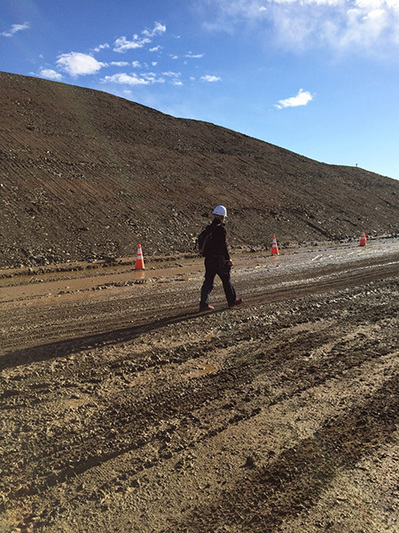
Leveling construction on the coastline of Rikuzentakata
Residency program headed by local companies engaged in reconstruction and community development, and started by local executives
Hinuma: The Rikuzentakata Artist in Residence Program is run by a local company called Natsukashii Mirai Souzou (Ancient Future Creation), and I work as program director. Natsukashii Mirai Souzou was founded in October 2011 primarily by entrepreneurs from Rikuzentakata with the help of the Iwate Prefecture Association of Small Business Entrepreneurs, among others. It was founded as a reconstruction and community development company to create "positive social capital" to expand the future horizons of the community, and to help create the environment for the next generation. The company's mission is to leverage the community's social capital while tackling the issues of the day. It aims to achieve the creation of jobs for 500 people and to produce multiple businesses in the future, and plans to disband to allow for further developments after 10 years.
Hakoneyama Terrace is an accommodation facility that opened in September 2014 as one of the largest projects of Natsukashii Mirai Souzou. Situated on the side of the mountain overlooking Hirota Bay, the facility is surrounded by a striking environment that is a world apart from the stark reality of the destruction and leveling work. With a theme to harness the strengths of trees and people, Hakoneyama Terrace was built with the hopes that in addition to use of the facility for lodging and group training, it would become a place of gathering for those thinking of both the present and future of Rikuzentakata where they can freely interact with the local residents. The employees consist of local residents, and meals are prepared with local ingredients. The facility is also focused on spreading the use of the pellet boiler heating system using wood chips, left over from the precutting of wood, in an effort to put the energy systems of the future into practice.
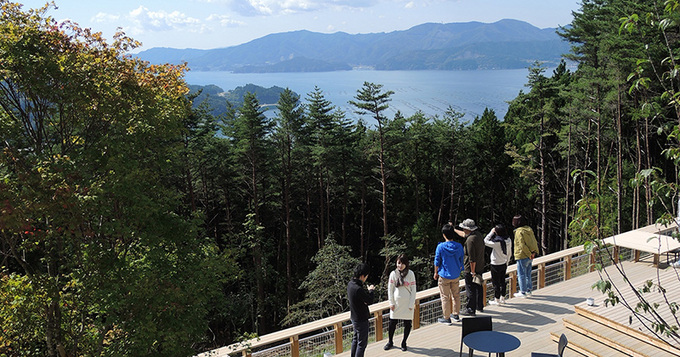
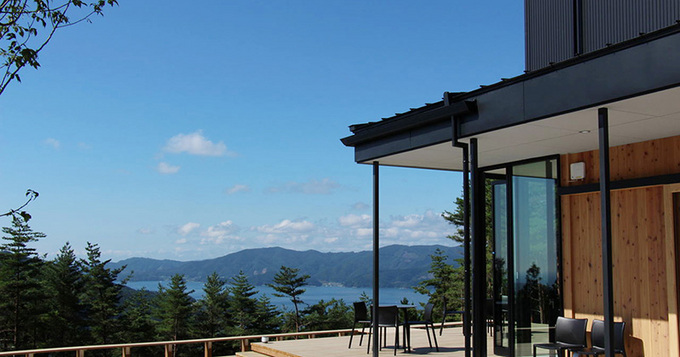
Hakoneyama Terrace
(Photos: Hakoneyama Terrace)
The Rikuzentakata Artist in Residence Program plans to carry out its activities in cooperation with such organizations as the Hakoneyama Terrace. Like the company Natsukashii Mirai Souzou, the philosophy of the residency program is to leverage the local resources in the hopes of creating new value. The aim is to create a place that helps recall our important memories and connects them to the future by creating a flow of people through the network of members from a variety of organizations based not only in Rikuzentakata but throughout Tohoku to collect, record, and present the memories at risk of being lost by artists. We plan on focusing on the three genres of visual arts, architecture, and design. Visual arts will focus on the creation, discovery, and communication of new value. Architecture will focus on landscape, environmental and town development. Design will focus on life design and new functionality. We intend to invite artists and curators based on each of these goals. We also have three programs. The first is an invitational program to bring two artists from overseas to stay for a period of between one and two months. The second is a network project to have artists travel around the Tohoku region to carry out a variety of artistic activities. Finally, there is the workshop program that is ongoing in cooperation with Hakoneyama Terrace to train new personnel to run the residency program.
We invited three artists during the first year in 2013. One of them was photographer Leo van der Kleij from the Netherlands. He spent his time photographing scenes from daily life in Rikuzentakata to record the present. He also installed a container gallery in the temporary shopping area to carry out a photographic exhibit that changed on a daily basis. Finally, he has published a document book in the Netherlands, which contained the photographs he amassed from Rikuzentakata and texts in English, Japanese, and Dutch. There was also the media artist Jaime Jesus C. Pacena II from the Philippines who produced promotional videos for musicians from Rikuzentakata. The third is the dancer and choreographer Sioned Huws who continues to participate this year. She spent her time dancing with the mothers living in the temporary housing of Rikuzentakata and researching the folk arts remaining in the community.
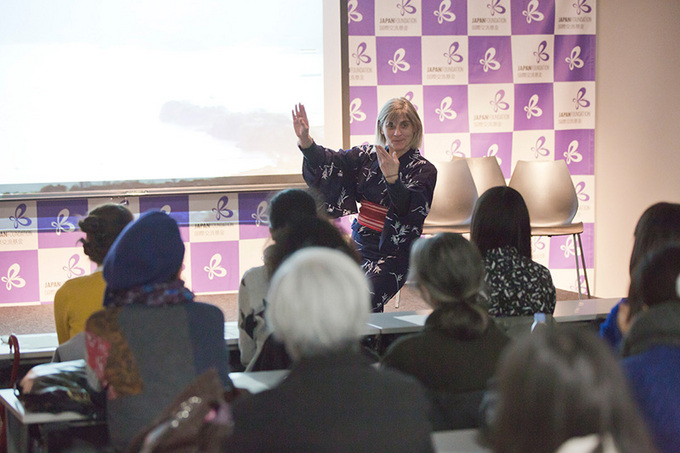
Sioned Huws performing "Rikuzentakata Ondo" during the talk event
In February 2014, we were given an opportunity to present our works to date at the Performing Arts Meeting (TPAM) 2014. We also held the Rikuzentakata Meeting at Hakoneyama Terrace in October. At the meeting, we introduced our activities and discussed how to approach our upcoming programs with an array of people including curators from the Rias Ark Museum, individuals running programs in Minami Sanriku, directors running art projects in Shiogama City, Miyagi Prefecture and various places throughout Tohoku, and various young students and members of the community.
While our steps at this point are still very small, we and the artists are doing our best to further our activities. We intend to continue working with Rikuzentakata and Tohoku, and steadfastly maintain our vision
Rikuzentakata of today as seen by three participating artists
Sioned Huws: Before I first visited Rikuzentakata in 2014, I was very worried as to whether there was anything that art or culture could do for a place that had been damaged so severely. Now, however, my attitude has completely changed. The people of Rikuzentakata are gentle hearted and tolerant, and they continue to hold their hometown and the former beautiful geography close to the heart. Now I feel that I see Rikuzentakata through the eyes of the people who live there. More than the loss of individual memories, the people are all worried and deeply saddened by the possibility of losing their collective memories as a community. Currently I am learning Rikuzentakata Ondo," which is a kind of Bon festival dance, at three different temporary housing areas. I believe that through our involvement in these activities, we are helping connect the scenery that everyone holds in their hearts to the next generation.
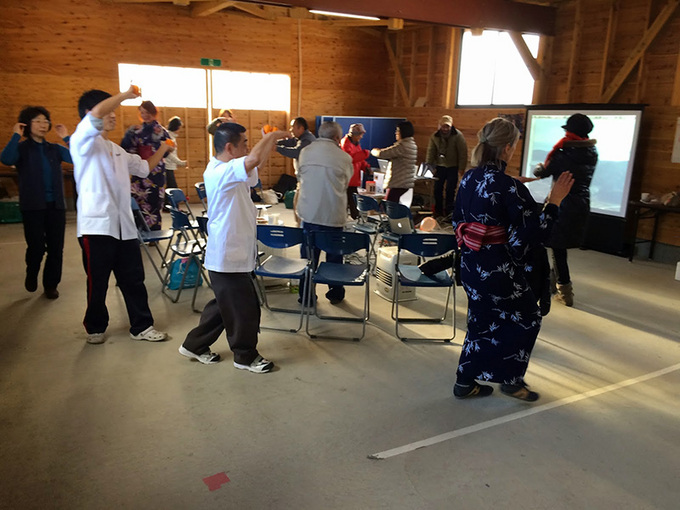
Sioned Huws performing "Rikuzentakata Ondo" with residents of temporary housing
Cornelia Konrads: I was deeply shocked by the scene I saw in Rikuzentakata. In addition to the damage from the tsunami, there was what was for us a second tsunami in the form of the destruction brought on by the leveling construction. However, afterwards, my feelings also changed after speaking to many different people I met. One thing an older woman told me particularly left an impression on me. "If there were only more beautiful things here, then many people would come to visit many times." There is a haiku by Matsuo Basho that I read long ago and found greatly inspiring:
"looking closely:
a shepherd's purse blossoming
beneath the hedge"
(Translated by David Landis Barnhill)
I changed my viewpoint to look for something like the small and beautiful shepherd's purse blossom in Rikuzentakata. I walked here and there for many days and took photographs. I found many beautiful things in the community from among which I collected broken pieces of pottery. In the future I would like to put them together into a work like a mosaic of some kind. I hope that the work that brings together things which were broken apart can once again tie together the memories of the people which had become scattered. 。
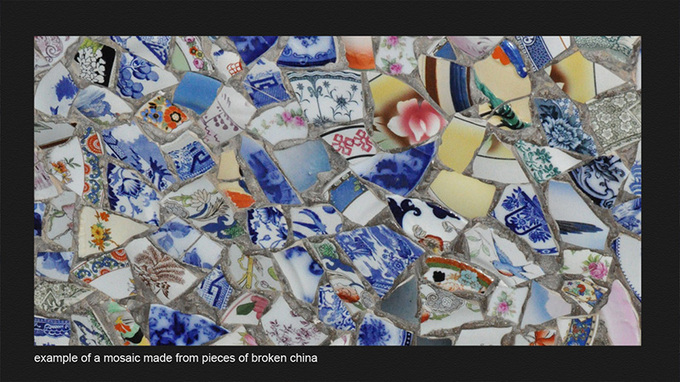
Mosaic of broken pottery found in Rikuzentakata © Cornelia Konrads
Tawatchai Pattanaporn: When I actually visited the affected area, I had a much different impression than the one I had been given by the information from the Thai media. The damaged areas were much greater in size than I expected, and the scale of the damage was far more severe than I had imagined. The current reconstruction plan calls for the creation of a completely new town in the damaged area. However, the town that exists in the hearts of the people has not changed. The important thing is that the people have a place of their own and have pride in themselves.
When visiting the homes of those affected, I noticed that everyone displayed to cherish photographs of themselves and their families. When everything is lost, photographs are a way to remember the past. As a photographer, I felt I wanted to capture these individual memories and histories, and somehow bring them back. I met an amateur photographer Murakami-san who had been taking photographs for 40 years, and had the opportunity to see his photographs of Rikuzentakata that had luckily not been damaged.
In the future, I would like to put on some kind of exhibition of these photographs in Rikuzentakata. I also hope to chronicle the transformation of Rikuzentakata through photographs.

Photography installation of images from the Sanriku Coast © Tawatchai Pattanaporn
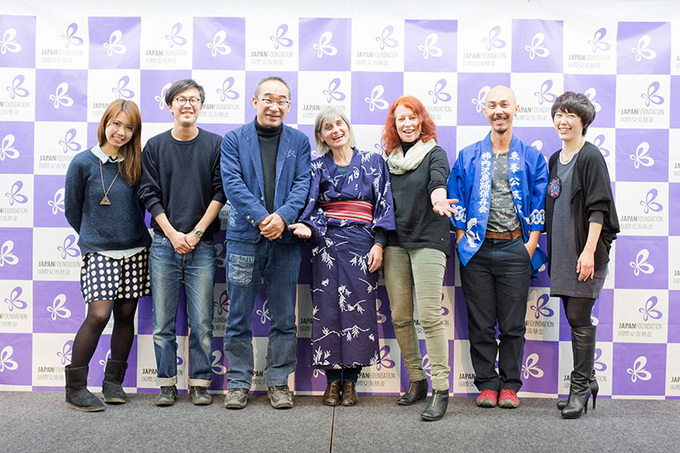
A group photograph including all the performers after the talk event
The residency of the artists in Rikuzentakata this time was extremely meaningful. The way that the viewpoints of the three resident artists were constantly different was also very stimulating. We learned from this that there are no borders in art. Further, the damages incurred by Rikuzentakata must be communicated to as many people as possible. If at all possible, I hope all of you take the time to visit the affected areas yourselves.
(Editor: Ayako Tomokawa, Talk event photos: Kenichi Aikawa)
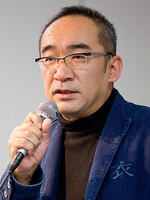 Norikazu Sato
Norikazu Sato
Executive Director, NPO Japan Contemporary Dance Network, Norikazu Sato was born in Hokkaido in 1960 and joined the butoh group Byakkosha in 1980. Until the group disbanded in 1994, he served as a butoh dancer and producer for domestic performances and overseas tours. In 1996, he received one-year training in art management at the Dance Theater Workshop in New York. In 1997, he participated in the Triangle Arts Program, which is a trilateral international project led by three partnering organization in the U.S., Indonesia, and Japan. In 2001, after a three year preparation period beginning in 1998, he established the NPO Japan Contemporary Dance Network in Kyoto to bring together individuals and organizations involved in dance including artists, event hosts, critics, companies, and foundations, from all over Japan, the Japan Contemporary Dance Network is involved in numerous activities throughout Japan to connect society and dance, including hosting Odori ni Ikuze!! (Let's Go Dancing), producing Dance File, operating dance performance/workshop reservation system Dance Reserve, and the coordination of workshops and performances. Starting in 2013, he has been carrying out exchanges with dancers from overseas and Japan to visit various parts of Tohoku (particularly areas affected by the earthquake) to learn folk arts. The Human Celebration--Sanriku International Arts Festival 2014 was held in Ofunato City Rikuzentakata City and Sumita, Iwate Prefecture, and Kesennuma City, Miyagi Prefecture in 2014, for a festival that combined local folk arts; gamelan from Bali, Indonesia; Korean pungmul folk music; community dance; and contemporary dance. There are plans to continue this festival in the future.
![]()
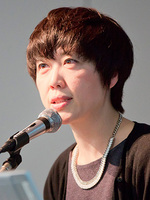 Teiko Hinuma
Teiko Hinuma
Program Director, Rikuzentakata AIR, Associate Professor at Joshibi University of Art and Design
Teiko Hinuma worked at a gallery planning company and as an editor for an arts magazine after graduating from the art department of the Joshibi University of Art and Design. Subsequently, in 1999, she worked at the preparation office to establish the Aomori Contemporary Art Centre, after which she worked as a curator there until 2011, providing support for artists, primarily through artist residency programs, and planning and running various projects and exhibits. She is currently the program director of the ARTizan, which is a citizen art support organization in Aomori, and one of the directors of the Art NPO Link. She became the program director of the Rikuzentakata AIR Program from 2013.
![]()
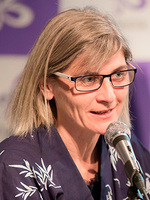 Sioned Huws
Sioned Huws
Rikuzentakata AIR participating artist
Sioned Huws is a choreographer and dancer born in Wales in 1965. She is currently based in London. From 1988 to 1990, she studied at the Merce Cunningham Studio in New York, and began choreographing and solo activities. She completed a work that combines choreography consisting of dancing on the floor on one's back based on te-odori (hand dancing) that is a traditional folk art of Tsugaru, as part of the Aomori Project that began in 2008. For the work, she received the cooperation of Yoshiya Ishikawa (master of Ishikawa school Tsugaru Te-odori), and the Hasegawa Sangenkai (Tsugaru shamisen/vocal group). From 2011 she has performed at gDA (London) and Chapter (Cardiff). She continues to develop, with recent performances including the da:ns festival 2012 in Singapore, as well as the E45 Napoli Fringe Festival and the Fabbrica Europa in Florence, in 2013.
![]()
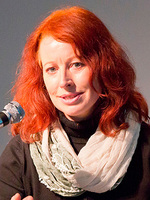 Cornelia Konrads
Cornelia Konrads
Rikuzentakata AIR participating artist
Cornelia Konrads was born in Wuppertal, Germany. After studying philosophy at university, she became active as a freelance artist beginning in 1998. Her interests are in creating site specific installations, both indoors and outdoors, permanent and temporary.
She is also a passionate traveler who has done exhibits, residency programs, and commissioned work throughout Europe, Asia, Australia, and the U.S. She creates works that open dialogs with the unique environments, buildings, geography, vegetation, and histories of each place she visits.
![]()
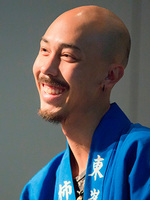 Tawatchai Pattanaporn
Tawatchai Pattanaporn
Rikuzentakata AIR participating artist
Tawatchai Pattanaporn is a specialist in traditional monochrome photography, and is very particular about using a dark room for developing and printing. He is also active in preserving film photographs, and writing articles about photography. He presents the diversity and complexity of society through his photographs. His works are always shot in monochrome, and they have the power to go beyond the limitations of photographic documentaries. He opened his studio in Bangkok in 2014 to focus on his creative activities that using traditional analog photography.
Keywords
- Dance
- Design
- Traditional Arts
- Architecture
- Arts/Contemporary Arts
- Economics/Industry
- Natural Environment
- NPO/NGO
- Art Management
- Peacebuilding
- Indonesia
- Thailand
- Philippines
- Netherlands
- Rikuzentakata AIR
- Japan Contemporary Dance Network
- Great East Japan Earthquake
- Touhoku
- the Human Celebration-Sanriku International Arts Festival
- Rikuzentakata AIR Program
- Rikuzentakata
- Ofunato City
- Rias Ark Museum of Art
- Kesennuma
- Gamelan
- Bali
- Aomori Contemporary Art Centre
- Natsukashii Mirai Souzou
- Iwate Prefecture Association
- Hakoneyama Terrace
- pellet boiler
- Jaime Jesus C. Pacena II
- TPAM
Back Issues
- 2023.12. 7 Movie Theaters aroun…
- 2023.6.16 The 49th Japan Found…
- 2023.4.24 The 49th Japan Found…
- 2022.12.27 Living Together with…
- 2022.12.27 Living Together with…
- 2022.8.12 Inner Diversity <…
- 2022.3.31 The 48th Japan Found…
- 2022.3.29 Beyond Disasters - T…
- 2021.11.29 Crossing Borders, En…
- 2021.4.13 Crossing Borders, En…

